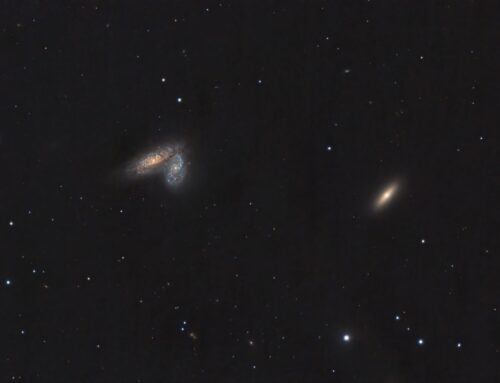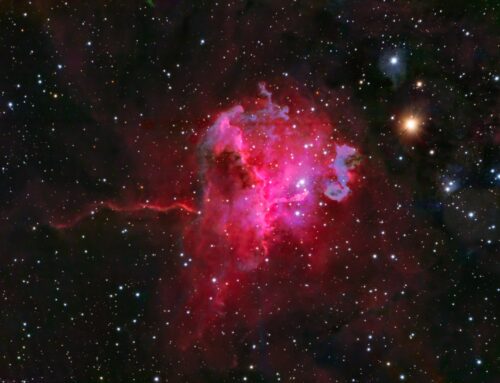NGC 7129
Click image for full size version
September 8, 2023
NGC 7129 is located in the constellation Cepheus. NGC 7129 has two parts: an open cluster, and pretty surrounding nebulosity. The open cluster is a group of stars that formed together, and are gradually drifting apart. The nebula surrounding the cluster is of a few different kinds: emission nebula (red, due to glow of hydrogen gas), reflection nebula (bluish, due to light from the brightest stars reflecting off particles of dust around them, and dark nebula (the dark lanes in the core and in the area around the nebula). The cluster contains more than 100 stars, each less than a million years old — newborns by stellar standards. NGC 7129 is relatively close, at a little more than 3,000 light years. I’ve read that the three bright stars in the nebula are blowing a bubble in the middle of the nebula. Here is a view of this object in a wider field, imaged by me in 2011 and 2013 (rotated 90 degrees clockwise compared to the photo above, which has North up).
Tekkies:
Acquisition, focusing, and control of Paramount MX mount with N.I.N.A., TheSkyX and PHD2. Primalucelab low-profile 2″ Essato focuser and ARCO rotator. Equipment control with PrimaLuce Labs Eagle 4 Pro computer. All pre-processing and processing in PixInsight. Acquired from my SkyShed in Guelph. Average transparency and seeing. Data acquired Sept 5-6, 2023 in a moderately moonlit sky.
Celestron 14″ EDGE HD telescope at f/11 (3,912 mm focal length) and QHY600M camera binned 2×2 with Optolong filters.
12x5m Red = 1hr00m
12x5m Green = 1hr00m
10x5m Blue = 0hr50m
16x5m Ha = 1hr20m
25x5m Lum = 2hr05m
Total: 6hr15m
Preprocessing: The WeightedBatchPreProcessing script was used to perform calibration, cosmetic correction, weighting, registration, local normalization and integration of all frames.
Colour master: A colour master was made from the Red, Green and Blue masters using ChannelCombination in RGB mode.
Gradient Removal: DynamicBackgroundExtraction was applied to the RGB, Ha and Lum masters.
Colour Calibration: ColorCalibration was used to calibrate the RGB master.
Deconvolution: BlurXterminator was used on the Ha, Lum and RGB masters with Automatic psf , and star sharpening set to 0.10 with “Correct First” selected.
Linear Noise Reduction: NoiseXterminator was applied to each master image with settings Amount=0.9 and Detail=0.15
Stretching: HistogramTransformation was applied to the RGB, Ha and Lum image to make pleasing images. Approximate background level after stretch was 0.10 for RGB and Lum, and 0.08 for Ha.
Nonlinear Processing
Luminance addition: LRGBCombination was applied to replace the lightness of the Colour image with the Luminance master.
Star Removal: StarXterminator was used to remove the stars from the resulting LRGB image, with Unscreen selected. Stars were removed from the Ha master and discarded.
Addition of Ha: PixelMath was used to blend Ha into the LRGB image using the following expression with parameter values a=1.2 and b=0.07.
Red: max($T[0], a*Ha)
Green: $T[1]
Blue: iif($T[0]<a*Ha, $T[2] + b * Ha, $T[2])
Nonlinear Noise Reduction: NoiseXterminator was used to reduce noise in the background areas of the image with settings Amount=0.9 and Detail=0.2
Histogram Stretch: HistogramTransformation was used to reset the black point and increase brightness in the galaxy slightly.
Contrast Enhancement: LocalHistogramEqualization was applied three times. A Contrast Limit of 1.5 and 1 iteration was used for each LHE application (scale 40, strength 0.25; scale 90, strength 0.25; scale 150, strength 0.18).
Sharpening: A mask was used to select brighter regions of nebulosity for sharpening with MultiscaleMedianTransform (Layers 1 – 5 with strengths of 0.01, 0.02, 0.02, 0.02, and 0.01, respectively).
Stars-only steps: MorphologicalTransformation was used in Morphological Selection mode to shrink the stars through a mask made by extracting the Luminance from the stars-only image. CurvesTransformation was used to add saturation to the stars. using the same mask.
Star Restoration: PixelMath expression combine(starless, stars, op_screen()) was used to combine the starless and stars-only images created with StarXterminator.
Final Steps: Background, galaxy and star brightness, contrast and saturation were adjusted in several iterations using CurvesTransformation with masks as required. ICCProfileTransformation (sRGB IEC61966-2.1; Relative Colorimetric with black point compensation) was applied prior to saving as a jpg. The finder chart was made using the FindingChart process.








Very nice Ron! Your images are always fantastic .
Gorgeous image, like always!